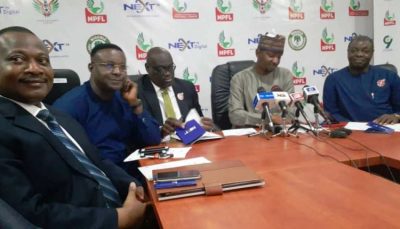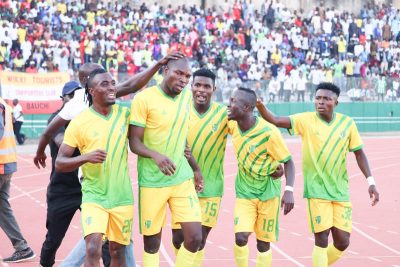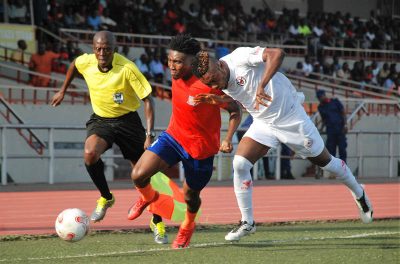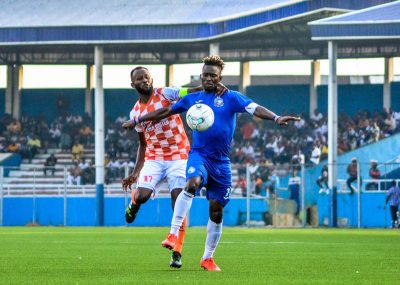By Steve Austin Nwabueze
The global obsession with footballers has created one of the great money spinners of the entertainment industry. In return for captivating audiences with their skills on the pitch, international soccer stars are now earning many more millions of dollars off the pitch being on television and other media; associating themselves with products from soft drinks to vehicles and airlines. A recent deal is set to raise the stakes even higher on home shores.
On November 7, 2019 the League Management Company of Nigeria; regulators of the Nigeria Professional Football League (NPFL), announced a multi-million-dollar broadcast deal with communication giants, Next TV worth a whopping US$225, 000, 000 (Two Hundred & Twenty-Five Million United States Dollars). This lucrative 5-year broadcast deal is certain to bring up issues on the image rights of the NPFL Players as more brands begin to leverage on this broadcast deal. But does this actually mean more income for NPFL athletes as it would with their international counterparts? The answer to this question might surprise you.

In today’s modern sporting world, image rights can hold enormous commercial value to both the professional athlete and his club. Image rights can be defined as the proprietary rights that arise from the commercial exploitation of a sporting personality’s name and image. Sports image rights are very valuable assets. The iconic 1970s English soccer player, Kevin Keegan was the first sports personality to enter actively into what was known at the time as a “face contract” for what were essentially his image rights.
What are image rights
In a football context, image rights are simply the right a player possesses to control, sell, license and otherwise monetize his or her likeness – that is, his or her image, name, nickname, voice, signature and all other characteristics unique to the player.
Image rights are broadly defined, using the expression “image” not in its narrow sense of “likeness” but in its wider sense of “persona” or “brand”, to use a marketing term.
In countries like England, Italy and Spain, where the commercial value of image rights is now recognized, most players often seek to create image rights companies and then assign those rights to these companies. This is done for tax purposes, as the revenue generated from the exploitation of the player’s image rights will be taxed at corporate tax rates, which are typically substantially lower than personal income tax rates. Non-UK players who are playing football in the UK will often set up both UK and offshore image rights companies. In these situations, the player’s UK image rights will be assigned to the UK image rights company, and his global image rights will be assigned to the offshore image rights companies.
Treatment of image rights In Europe and the United States
Image rights are also known by different names and subject to different legal treatment in different jurisdictions. In the United Kingdom, they are known as image rights; in continental Europe, as personality rights; and in the United States as publicity rights. Nigeria has followed its colonial traditions by adopting the English position. Accordingly, the country’s colonial past has birthed the concept of ‘image rights’ as they are viewed in most common law countries. Therefore, in stark contrast to the laws of other foreign jurisdictions, neither English law nor Nigerian law offers a specific, statute-based law protection in relation to image rights. France for instance, has what is called “personality rights” which are protected under Article 9 of the French Civil Code. In the United States, it is known as the ‘right of publicity’. The right of publicity purports to protect against uncompensated commercial exploitation of a person (such as an athlete’s) likeness or identity. Every person, celebrity or non-celebrity, has a right of publicity – which in short, is the right to own, protect and commercially exploit one’s identity.

The protection afforded to the right of publicity in the United States stems from, and is intertwined with, the right of privacy.
The term “right of publicity” was coined by Judge Jerome Frank in 1953 in Haelan Laboratories, Inc v Topps Chewing Gum, Inc, which for the first time affirmed that individuals (in this case, Major League Baseball players) possess a property right in their own images. This right in the United States, it must be stated, varies from state to state. Nevertheless, the right of publicity underpins the protection which inures to a player in respect of uncompensated commercial exploitation of a player’s image. The approach in England and most common law countries including Nigeria is to rely on a framework of statutory and common law intellectual property rights to prevent unauthorized exploitation.
Remedies available for breach of image rights
Infringements of image rights have become rife in the entertainment and sports industries. However, the absence of a statutory framework in seeking a redress has not deterred their owners from bringing actions in court. Players/image rights companies have often resorted to activating the provisions in the trademark and copyright law as well as the common law doctrine of passing off. Some of the notable cases in this area is the widely reported case of Robyn (Rihanna) Fenty v Arcadia Group. As regards copyright, Nigeria copyright law automatically confers a property right on the author of original works which can include literary, dramatic, musical or artistic works. There is, however, no copyright in a player’s face or his name because they are not original works. The copyright in a photograph of Cristiano Ronaldo will belong to the photographer (save there is an assignment). Likewise, the copyright in an audio recording of a media interview will belong to the interviewer. As a result, the law of copyright is of limited use to professional athletes.
Also Read: The Professional Athlete as an Employee Within The Context of The NPFL Rules
A trademark is a registrable intellectual property right which comprises any sign capable of being reproduced graphically and capable of distinguishing goods and services of one undertaking from those of another undertaking. Sporting personalities can apply to register trademarks comprising their name, slogans, logo (amongst others) but such signs will only qualify for registration in Nigeria if they are sufficiently distinctive and unique.
Intellectual property lawyers representing aggrieved athletes have devised an ingenious way of surmounting the procedural hurdles associated with seeking an appropriate redress for their clients. They have resorted to the common law remedy of passing off. As some of the notable cases on the point would show, a greater percentage of the successful lawsuits on breaches of image rights succeeded where the players’ legal representatives relied on the common law remedy of passing off. One of the two notable cases in this area is the case of Rihanna (Fenty Group) and Arcadia Group. The second case is the widely reported case of Mohammed Salah v Egypt Football Federation. Even though the parties in this case somehow managed not to institute any litigation on this case, valuable lessons were learnt by not only the parties to the dispute but other football federations on the extent of their powers with respect to exploiting the image rights of a player. It is pertinent at this point to make comments on both cases.

Robyn (Rihanna) Fenty v Arcadia Group
In this case, popular style and fashion icon, Rihanna sued Topshop, a member of the Arcadia Group for selling a T-shirt bearing her image. The image had been photographed by an independent photographer and Topshop had obtained a licence to use the image from the photographer but not from Rihanna herself. Rihanna argued that the sale of the T-shirt bearing her image infringed her rights on the grounds of passing off, on the basis that the general public would assume that she had licensed the use of her image to Topshop. Topshop on the other hand, argued that customers would always buy the shirt because they liked the product and the image for their own individual qualities and that there was nothing on the T-shirt which represented it as an item of Rihanna’s official merchandise. In arriving at its decision, the judge found for the plaintiff and held that Topshop’s conduct amounted to a misrepresentation to the general public that Rihanna had in fact endorsed the sale of the T-shirt. As a result, it was found that a large number of purchasers were likely to have been deceived by Topshop into purchasing the T-shirt.
Mohammed Salah v Egyptian Football Federation
The dispute between Egypt and Liverpool striker, Mohamed Salah centered on the unauthorized use of the former’s image. This dispute, after a long simmering cold war was only made public in April 2018 following a social media spat between the player’s representatives and the Football Association’s representatives.
In late 2017, Mr Abou-Rida, acting in his capacity as Egypt Football Federation chairman, allegedly made a phone call to Mr Salah and “encouraged him to give preference to the sponsors of the Egyptian Football Association” in relation to the licencing of Salah’s worldwide image rights, which are controlled by the player’s image rights company, MSCC.
In the days following, Mr Abbas received an unsolicited letter from a company called “Presentation”, which held itself out to “be the main and only sponsor of the Egyptian Football Association.” Presentation signed a deal with the EFA for the exclusive sponsorship and commercial rights surrounding the national team. Presentation requested that Mr Abbas provide information relating to ongoing negotiations for the use of Mr Salah’s image rights as well as guidance on what the EFA would have to do in order to purchase the rights to a photo shoot featuring Mr Salah.
Mr Abbas queried Presentation as to why it would require this information but did not receive a response. Accordingly, Mr.Abbas requested that the EFA, Presentation and Egypt Air, and any and all other relevant commercial partners cease and desist using or authorizing the use of Mr. Salah’s image without express written consent from MSCC.
Mr Abou-Rida and the EFA maintained that they had the right to use Mr Salah’s image, but shortly thereafter, announced that the EFA would remove Mr Salah’s image from its promotional materials and cease the use of his image alongside the WE logo on the Egypt Air aeroplane. Somehow, the parties resolved their differences shortly before the world cup in Russia. Had the two parties failed to resolve this dispute, Mohammed Salah would have been able to bring an action for passing off.
The Nigeria Professional Football League
At the outset of a player’s career, his image rights are owned by the player in so far as they cannot be exploited, licensed or assigned without his prior consent. In general, elite international players will license their image rights to three broad categories of licensee (i) their club (ii) their personal sponsors and (iii) national association.
Under the NPFL Rules, the player’s image rights obligations are expressly incorporated in Form 7 of the Rules, specifically in Clause 4.3 through 4.7. Clause 4.3 of the contract is the assignment clause that recognizes the club’s rights to exploit the player’s image rights. By clause 4.4, the player agrees not to undertake any promotional activities on the club’s behalf nor assign his image rights to any other person. The player is further obliged under article 4.5 of the contract to undertake promotional activities on behalf of the club. This clause is complemented by clause 4.6 where the player expressly assigns the copyright to his photographs to the club and grants to the club, permission to exploit his image for promotional purposes. However, it is pertinent to point out that the exploitation of a player’s image imposes a corresponding obligation on the club to ensure that such usage is not subjected to any greater usage than that of his teammates. The club is also obliged to ensure that the player’s photograph or image does not imply an endorsement by the player of the product or service being promoted. This was the thrust of the dispute between Mohammed Salah and the Egypt Football Federation where the player’s representatives alleged that their client’s image was subjected to greater use more than that of his teammates and gave the impression that the player endorsed the use of Egypt Air.

What happens where a player’s promotional obligations to a personal sponsor conflicts with that of his club or even the league? Take a hypothetical example; Hamidu plays for Benue Comets FC who are sponsored by a soft drink brand. Before signing up with Benue Comets, he had a personal promotional obligation to another soft drink brand. Would it be right for Hamidu to breach his obligations to his personal sponsors under the pretext of observing similar obligations to his club?
Curiously, the drafters of the NPFL Rules have made no provisions in this regard. Typically, these situations are addressed by including non-compete clauses in the standard contracts which precludes the players from endorsing competing brands with the league’s or club’s sponsors. Clause 4.3 of the English FA standard contract contains such clause which precludes the player from endorsing a competing brand during the term of his contract. English and some European clubs have found a way to navigate this provision especially when it comes to club’s high-profile players. The case of iconic Swedish striker, Zlatan Ibrahimovic and Manchester United easily comes to mind. The swede had prior to joining the former English champions in 2016 endorsed Swedish car Manufacturing giants, Volvo. This deal ensured Zlatan never endorsed American auto brand, Chevrolet one of the biggest auto brands endorsed by Manchester United. Instead of dropping his personal sponsors, Zlatan did the exact opposite and carried on with his personal sponsors. That is what can happen with a player with the profile of Zlatan Ibrahimovic. What happens where the player is of a less iconic status? In any event, European clubs typically respect existing endorsements by a player and make exceptions of such scenarios.
What are the different options available?
There are three main ways that an athlete can seek to commercialize his or her rights.
Sponsorship: Under a sponsorship arrangement, a corporate brand pays the athlete (or provides the athlete with products) in exchange for being granted certain marketing rights by the athlete, in order to promote the brand’s image generally. The marketing rights might take the form of participation in advertising, or wearing branded clothing, for instance.
Endorsement: An endorsement arrangement goes one step further than this. It involves the personal recommendation by the athlete of products made by the sponsoring brand, or at least a close association between the athlete and those products. In this case, the brand in question is not merely seeking to raise its profile but to affect purchasing patterns of the public. For example, many premium and luxury watch manufacturers have endorsement arrangements with athletes.
Merchandising: Merchandising arrangements operate by monetizing the athlete’s own image rights and status, by applying it to the athlete’s ‘personal’ range of products. Generally merchandising requires considerable investment of resource into protecting and growing the athlete’s own image and ‘brand’, including investment in a trade mark portfolio. This goes beyond what most athletes would require and this blog does not provide further detail on merchandising.
It is understandable why the Nigerian league has not deemed it necessary to insert non-compete clauses in the standard player contracts. The burgeoning commercial profile of the league is just becoming more enhanced with the signing of the first broadcast deal last week. It is only a matter of time before high profile brands besiege the league headquarters to leverage on the immense commercial potentials of the league. This would undoubtedly increase the purchasing power of the clubs to buy high profile players with existing personal brands sponsors and then the legal fireworks would start unless this lacuna is addressed immediately. Can more be done within the framework of the NPFL rules to empower Nigerian players to enjoy the commercial use of their image rights?
References
1. Carol Couse and Jake Cohen, ‘Case review: US Soccer Federation v National Players Association (use of player likenesses)’, LawInSport, 2 February 2017, last accessed 9 April 2019, available at https://www.lawinsport.com/topics/articles/item/case-review-us-soccer-federation-v-national-players-association-use-of-player-likenesses.
2. KingFut, “Legal letters explain dispute between Mohamed Salah, Egyptian FA” KingFut, 25 April 2018, last viewed 9 April 2019, available at https://www.kingfut.com/2018/04/25/mohamed-salah-egyptian-fa-exclusive.
3. Ibid.
4. Abdel Rahman Shuwaikh, “Solution for Salah’s image rights to see light soon,” Daily News Egypt, 11 October 2018.
5. Egypt Today, “Salah dispute with EFA escalated, 28 August 2018, last viewed 19 March 2019, available at https://www.egypttoday.com/Article/1/56730/Salah-s-dispute-with-EFA-escalated.
6. Haelan Laboratories, Inc. v. Topps Chewing Gum, Inc., 202 F.2d 866 (2d Cir. 1953).
7. Robyn (Rihanna) Fenty v Arcadia Group (2013) EWHC2310 (Ch).
8. Rule 4 of the Premier league Rules 2017/18
9. Rule 4 of the NPFL Framework Rules 2015/16
10. Form 7 of the NPFL Rules.
11. Fletcher, Paul and Grant, Tom (Image Rights; Article publication in Football and the Law by Nick De Marco, QC) 2018 page 239, 240 and 241.
12. Nick De Marco, QC (Football and the law; 2018) page 242-243
15. https://www.penningtonslaw.com/news-publications/latest-news/2017/the-lifecycle-of-an-international-athlete-negotiating-sponsorship-and-endorsements-deals
Steve Austin Nwabueze is a lawyer; Senior Associate and the team lead of the Sports and Entertainment team of Perchstone and Graeys LP, Lagos.
(08032336584)







